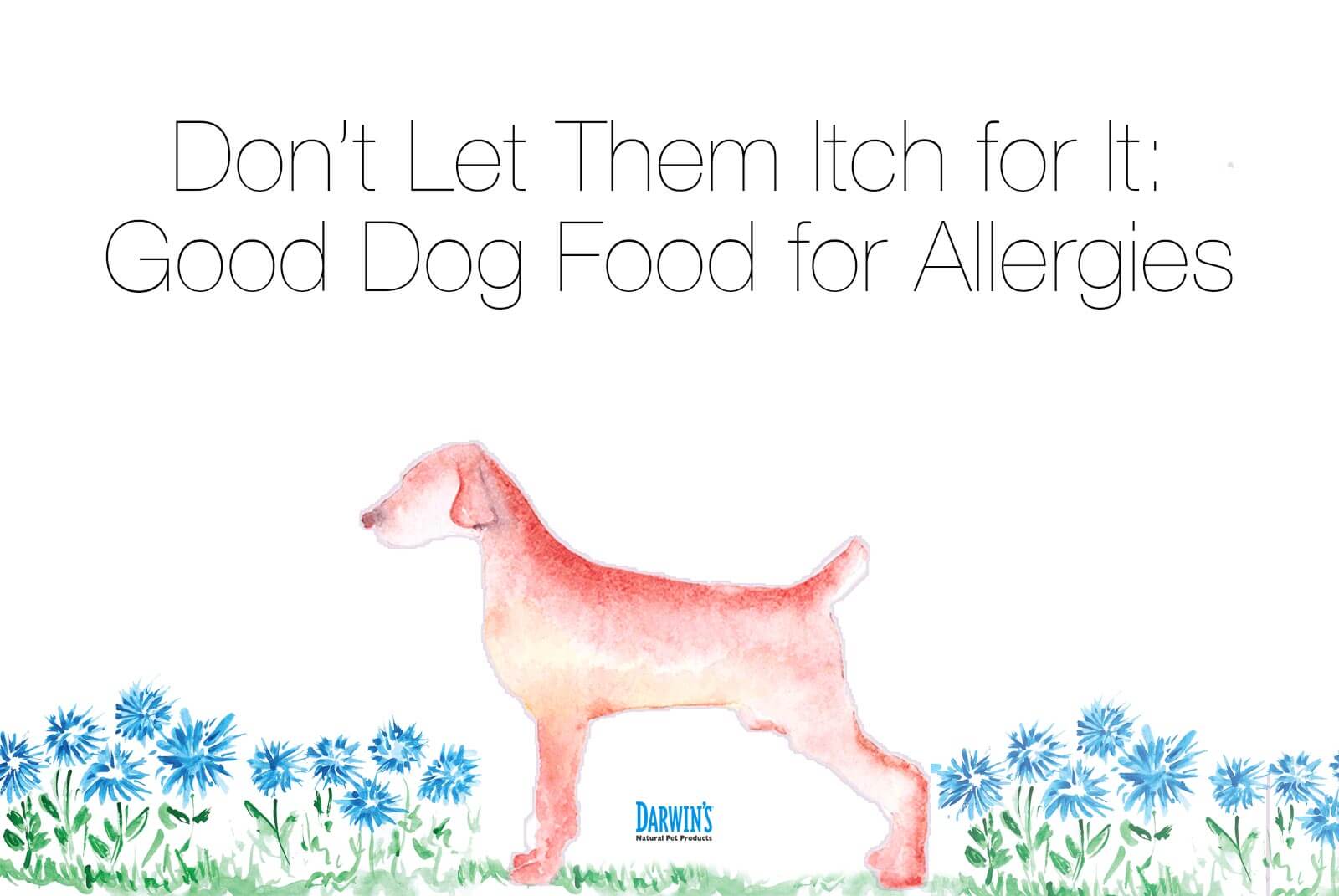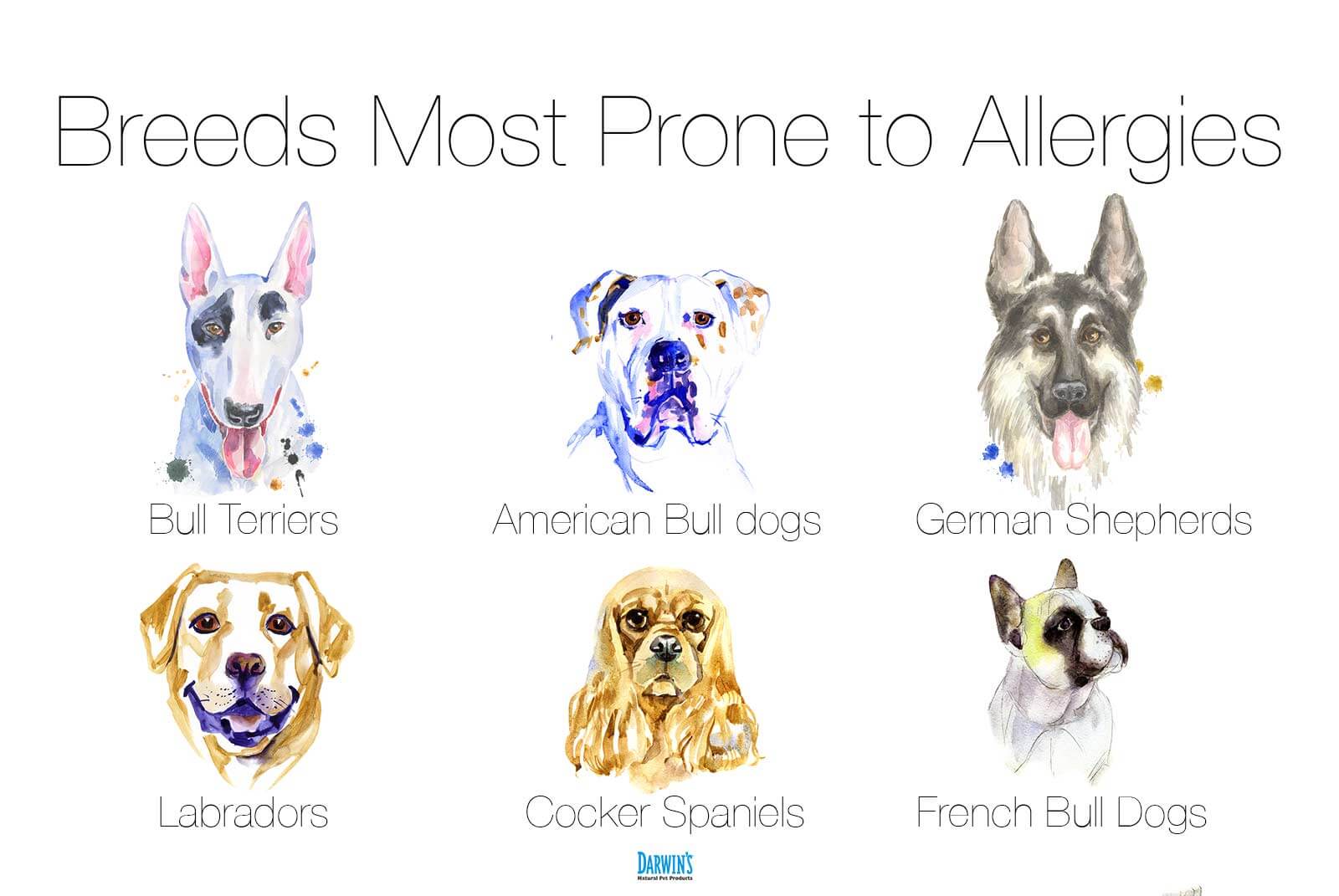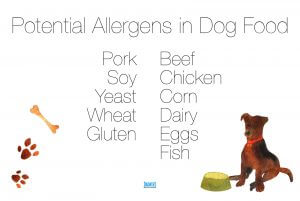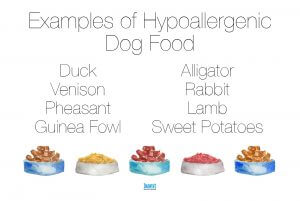How to Choose the Best Hypoallergenic Dog Food for Allergies
1/16/17

Last Updated on
He’s obsessively biting his paws. He keeps licking his bum. She’s shaking her head and pawing at her ears. Could your dog have a food allergy? As with humans, allergies in dogs usually appear after prolonged exposure to a triggering substance, called an allergen. But how do you know it’s an allergy and more importantly, how do you remedy the problem? We’ll look at allergies in dogs, their causes, and explore how the right dog food diet can help ease their discomfort.
What Is an Allergy?
An allergy, or hypersensitivity, is the body’s inability to tolerate certain plant and animal substances, usually proteins. The body considers the substance a threat and generates antibodies to fight it. Allergies can result from exposure to foods or from environmental sources. In some circumstances, an allergic reaction can lead to severe illness and even injury to organs, or death.
Food Intolerances
The appearance of an allergy may be similar to a food intolerance, which is not an immune problem but a digestive one. In this instance, the body cannot properly digest a substance. While allergies develop over time, food intolerances usually present the first time the dog eats the food.
Food intolerances can cause discomfort or even minor illness. An example of a food intolerance is lactose intolerance or the inability to tolerate cow’s milk and cheese. A dog who eats cheese may experience diarrhea or vomiting, but the discomfort is usually temporary. The good news is that your dog probably doesn’t have an allergy.
Dr. Judy Morgan is a holistic veterinarian and author of three books on animal nutrition and health. “Food intolerances are probably a lot more common than true allergies,” she declares.

What Are Non-Food or Environmental Allergies?
Most allergies in dogs stem from environmental sources, with only about 10 percent attributable to food. Environmental allergies in pets appear similar to food allergies, usually with itchy skin all over the body and paws, and ear infections. “Environmental allergies may be seasonal or not, depending on the allergen,” explains Dr. Judy. Fleas, dust mites, tree and grass pollens are common culprits, but so are household cleaners, air fresheners, and cigarette smoke, which can trigger reactions year-round. Control environmental allergies by wiping your dog’s paws and coat after walks, ensuring that cleaning products are natural and agreeable to the dog, and using an air purifier to clear mites and other air-borne allergens.
How Can You Tell if Your Dog Has an Allergy and Needs Hypoallergenic Dog Food?
Because food allergies are not common, you can look for signposts to isolate the causes. “Generally, if a dog is scratching non-seasonally, I will look at food as a possible cause of the scratching,” suggests Dr. Judy. Food allergies also present differently in dogs than in humans. In dogs, allergies are usually expressed through the skin, but they may present other symptoms. “A rule of thumb, but certainly not in 100 percent of cases, is that food allergies cause more itching around the head and face, with yeasty ear infections, while environmental allergies show up in other areas such as chronic foot-licking,” Dr. Judy explains. Watch for these signs:
- Chronic or recurring infections, especially in the ears.
- Head shaking and pawing at ears.
- Itching outside of season.
- Obsessive licking, skin or paw biting, or scratching.
- Chewed-up hair on stomach, back, bottom, or paws.
- A rash or hives. But remember, skin problems may not be obvious in your dog because the skin is usually hidden by fur.
Although more commonly associated with food intolerances, allergies in dogs may also present as sneezing, nausea, vomiting, gas, and diarrhea. Since topical allergies, food allergies, and food intolerances all present similarly, always consider getting the help of a veterinarian to diagnose the problem.
How Do Dogs Get Food Allergies?
As in humans, allergies are generally built up over time with prolonged exposure to an allergen. For example, a child who spends years walking through mosses and trees on the rainy West Coast may build pollen allergies as she approaches her 30s. Similarly, a dog who likes to eat one brand of beef dog food may suddenly become allergic to the ingredients. Dr. Judy says that “Dogs develop allergies for many reasons, including genetics, environmental toxins, and over-stimulation of the immune system by vaccines, drugs, and chemicals.”
Indeed, it is thought that puppies who are weaned too early are more susceptible because they did not receive a sufficient dose of antibodies from mother’s milk. Dr. Judy also suggests that the immune health of the mother and the quality of the colostrum, or first milk, influences the later health of puppies.
Some evidence also suggests that pups who received antibiotics at an extremely young age are more likely to develop allergies because the drugs change the digestive system. “Antibiotics affect the immune system because they kill the beneficial bacteria in the gut that are responsible for up to 80 percent of good immune function,” says Dr. Judy. Puppies in less than ideal environments may experience a double whammy of bad nurturing. “Many puppies that are weaned early are also vaccinated early and often, which further stresses the immune system,” she says. Among potential problems with excessive vaccination is the potential to contribute to allergies. As Dr. Judy explains further, “Vaccine cultures are commonly grown on egg cultures, which may lead to poultry intolerance, one of the most common problems I see.”

Some dog breeds are simply more prone to suffering allergies. Why? Possibly the breeding of animals that have allergies or animals that are too closely related, or certain breeds may just have a constitution prone to allergies. If you care for a member of these dog breeds, watch for allergy symptoms:
- German Shepherds
- Bull Terriers (Dr. Judy: “almost all of them!”)
- French Bull Dogs
- American Bull Dogs (“Particularly the white ones.”)
- Labradors
- Cocker Spaniels
Controlling and Healing Food and Environmental Allergy Symptoms
The only real way to heal allergy symptoms is to completely remove the allergen. However, particularly if the dog has suffered with the symptom for a while, it’s important to offer relief. Some vets strongly advocate for baths to remedy skin conditions. Bathing removes irritants on the skin and coat, soothing itchiness and hot spots. Special shampoos and topical sprays can also provide comfort. Allergy shots, antihistamines, and steroids such as Prednisone may offer temporary relief but are not long-term solutions.
How Can You Tell if Your Dog Is Allergic to Food?
When it comes to food allergies, the only way to really determine what’s causing the symptoms is through an elimination of food items and change of diet. Although skin and blood testing for allergies in dogs exists, some question its cost and effectiveness.
In an elimination diet you stop feeding what you believe is the problem food and feed a hypoallergenic diet, a diet with limited ingredients, so that the exact allergenic culprit can be narrowed down. Be aware that it is likely that if your dog has allergies, he may be allergic to more than one ingredient.
- Stop Feeding the Current Diet: Change the diet gradually over a week or two, slowly feeding less and less of the current diet. Change to a food the dog has never eaten before, with either limited ingredients or novel foods.
- Feed the New Diet for Eight to Twelve Weeks: During this period, watch to see if symptoms clear up. Look for at least some improvement in symptoms within four to six weeks. Some dog breeds may take longer to respond. Dr. Judy says she doesn’t add supplements for the first four weeks so that the source of reactions is clearer.
- Be Careful About What You Feed the Dog: Watch for items kids might feed the dog under the table. Read labels on all foods and treats, in addition to the ingredients found on flavored medicines and compounded medicines. If problems appear while feeding something that doesn’t contain your isolated food, consider that elements in the ingredients may contain allergens. And, be sure that your dog can’t sneak food—a dog who breaks into the pantry and gorges on leftover kibble isn’t helping her condition.
- After Symptoms Disappear, Do a Challenge Diet: Once symptoms disappear, gradually reintroduce the challenge foods, one protein at a time. Symptoms will appear within days to two weeks and may include stomach upset, loose stools, stomach rumbling, intense itching, or swelling of the face and ears. If symptoms do occur, remove the allergen again. However, if no reaction occurs, add another protein the following week. Be sure to keep a journal of foods used and reactions.
- Rotate Foods: After you determine the allergen, remove it from the diet, but also be sure to rotate new items in your dog’s food weekly or every few months. Remember that repeated, regular exposure to foods can lead to allergies. Rotating foods also helps strengthen a dog’s digestion, exposes her to a wider range of nutrients, and just makes meal times more interesting.
Is My Dog Allergic to Chicken?
Chicken is a complicated ingredient. It appears frequently in commercial food, which means dogs potentially eat a lot of it. Chicken naturally comes loaded with potentially inflammatory omega-6 fatty acids. In addition, commercial foods often use chicken that has been raised unethically and supplemented with steroids. If your dog eats a lot of chicken-based food and shows symptoms of allergies, try another food without chicken to see if the symptoms clear.
What Is a Good Hypoallergenic Dog Food?
The word hypoallergenic means “less” allergenic. It’s the food least likely to cause allergic reactions in dogs.
Three Hypoallergenic Dog Food Types
When treating food allergies in dogs, you have three types of hypoallergenic food to experiment with:
- Limited Ingredients: Limited ingredient recipes contain 10 or fewer ingredients, with usually five to seven ingredients, and often contain one protein and one carbohydrate. In this way, you can narrow your dog’s exposure to potential allergens. One good option is to feed your dog raw food since it has limited ingredients, no additives that are often culprits of allergies, and you know exactly what’s included in the recipe.
- Novel Ingredients: Novel foods are less commonly available and seldom eaten by most dogs. They include unique game, such as bison or pheasant; foods from other continents, such as kangaroo or bush rat; and alternative grains, such as millet.
- Prescription or Veterinary Food: Prescription food contains specific hypoallergenic ingredients, or hydrolyzed protein. At least one commercial dry food is available that is completely vegetarian to serve those dogs who are highly allergic to animal proteins. Made from hydrolyzed soy, some dogs eat it, but some won’t touch it.
With any commercial preparation, be aware that traces of allergens can always creep in during the production process. No laws or even official guidelines exist to describe the correct process for creating hypoallergenic dog foods. Some special commercial and prescription diets also contain artificial preservatives, such as BHA and BHT. BHA or butylated hydroxyanisole, and BHT or butylated hydroxytoluene are human-made chemical compounds commonly added as antioxidants to prepared human and animal foods, and cosmetics. Studies indicate they may be carcinogenic, although small amounts in food are permitted by the Food and Drug Administration.
The Nature of Hydrolyzed Protein
Hydrolyzed protein, contains chemically reduced molecules so small (amino acid chains are split) that a body cannot recognize them as antigens, or irritating allergenic components, and therefore, will not create a defense against them. But the solution may not be that simple. According to Dr. Judy, hydrolyzed products tend to be from chicken, corn, soy, or even chicken feathers. Experts suggest these diets are effective less than half the time. “Since chicken, corn, and soy are common allergens, it’s no wonder the foods don’t work well,” exclaims Dr. Judy.
Potential Allergens in Dog Food
To focus on hypoallergenic dog food, consider the items most commonly associated with allergic reactions:

Other possible allergens include potatoes, rice, rye, and other grains.
Some breeds and sizes of dog tolerate some foods better than others. For example, adult dogs may enjoy different foods than puppies. Active dogs who spend a lot of time outside may eat things, such as eggs, that more sedentary indoor dogs won’t eat.
The Best Foods for Dogs with Allergies
Particularly with commercially prepared foods, choices abound. But what are really the best hypoallergenic dog foods? The best dog foods for allergies isolate and remove the ingredient that provoke a reaction in your dog. Of course, in all instances, ethically raised sources are the best. Grain-free food may help for those animals who are gluten intolerant.
Aside from isolating allergens, the next important step is to look at novel foods, or foods your dog has not eaten before. Lamb may be novel for your dog, but it now also appears frequently in commercial recipes. Dr. Judy finds rabbit to be generally non-reactive. You may need to find a farmer’s market or specialty grocery store to find uncooked rabbit. Additional meat options include alligator (particularly in the southern United States), alpaca, goat, and ethically-raised pork. Dr. Judy also likes white fish, such as cod. Seafood, with its high levels of anti-inflammatory omega-3 fatty acids, can be an excellent diet choice. Be careful with the types and source of the fish and how much you feed your dog, as ocean fish often contain high levels of pollutants.
Carbohydrate Conundrums
Potatoes, both sweet and white, are often added as an alternative carbohydrate, but they too can present problems. Dr. Judy advises using white potatoes only as a temporary option because of the component solanine which can inflame arthritis symptoms. She also frequently sees dogs experience allergic reactions to sweet potatoes. “They are not my first choice,” she cautions. In addition, legumes–peas, chickpeas, lentils–can be problematic. “I am seeing a ton of problems with them and recommend avoiding them. Legumes are commonly affected by aflatoxins from molds, which stress liver function,” Dr. Judy explains.
Added extras include vitamins C and E, lutein and taurine, beta carotene, dried lactobacillus and acidophilus for digestive health, and antioxidants such as fish oil. For dried food, look for green tea as a preservative.
Moving Forward with a Good Dog Food Diet for Allergies
Dr. Judy suggests trying one protein and one vegetable and has had good results from butternut squash. “A lot of dogs with food or digestion problems don’t digest grain-type ingredients, but quinoa is sometimes feasible.”

Healing Hypoallergenic Foods for Dogs
If dogs suffer the ill effects from of the wrong foods, they can also be healed of allergies and food intolerances with the right foods. Dr. Judy thinks that after following a strict diet that eliminates offending foods, a dog may even be able to eat them again. “I have had some of my own dogs that seemed to have allergies to chicken or beef or whatever, that have the ability to eat the offending ingredient after a year without it.” But she cautions that real healing seems possible only with a clean diet of whole foods. “Trying to go back to a dry kibble with dozens of ingredients that may include chicken meal may not work but feeding fresh cooked or raw chicken may work.” Dr. Judy also recommends rebuilding the intestinal strength and repopulating gut bacteria through a good quality probiotic or probiotic source, such as fermented goats milk or green tripe.
Good dog foods can also help to heal environmental allergies. “Since 80 percent of the immune function comes from the gut, when you heal the gut you heal the immune system,” states Dr. Judy. She focuses on energetically “cooling” foods of Chinese Traditional Medicine practices– such as rabbit and white fish–for soothing digestive issues. “Many of my patients have environmental allergies that become very manageable with minimal or no required medications once the gut is made healthier.”
Homemade and Raw Options for Hypoallergenic Dog Food
To reassure yourself that you are implementing the best control on allergens during food elimination tests and when controlling exposure to known allergens, homemade and raw foods may be good options for hypoallergenic dog food. However, understand that when you prepare your own foods for your dog, you must strive to create a balanced diet.
Get Hypoallergenic Dog Food Delivered to Your Home
At Darwin’s Pet Products, our number one goal is to help keep your pets healthy and active for as long as possible and a diet consisting of hypoallergenic dog food can help. To help accomplish this goal, we provide a library of articles in the hope of providing consumers with useful information to help their pets. And, primarily, we produce affordable, high-quality raw dog and cat meals which we ship directly to consumers, so they are as fresh and convenient as possible. Our meals are high in protein, gluten-free, wheat free, and are created to provide complete and balanced nutrition. We encourage you to learn more about our meals for dogs and meals for cats.
If you think you might want a trial of Darwin’s pet food (at an introductory price), we would love to send you our meals and hear how much your dog or cat loves them.



